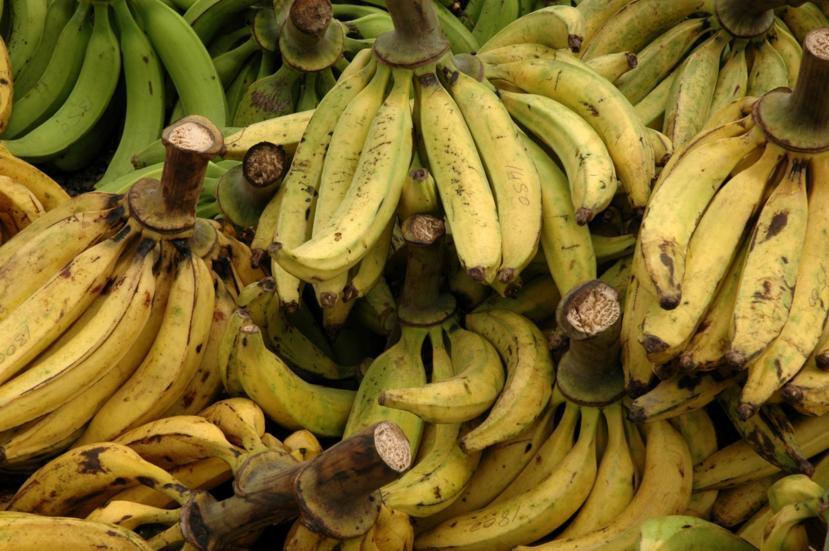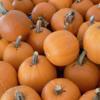What Is a Plantain?

A plantain, also known as a plátano in Spanish, is closely related to a cultivar of dessert banana. In general, a plantain is classified as a vegetable, just like other fellow tropical products, such as yams, sweet potatoes, taro, and potatoes. Like a banana, a plantain, too, belongs to the Musaceae family. In its natural habitat, the plantain was thought to be a cross-breed of two wild species of Musaceae, M. balbisiana Colla (BB) and Musa acuminata Colla (AA).
Unlike bananas, however, plantains are cooked before serving, as they are unsuitable to eat raw. The plantain is used in many dishes, just like a potato would be used, and is common in Caribbean and west African countries. Plantains are mainly baked or fried, but can also be served steamed. They are considered a delicacy in many countries.
Plantain plants are native to India and are mainly grown in tropical climates. They are sometimes called the potatoes or pasta of the Caribbean. Plantains are mainly sold in the produce section of a supermarket, and they resemble unripe bananas. However, ripe ones may sometimes be black in color. There are various strains of plantains with differing outward appearances, and some are cooked specifically for one purpose more than another.
A plantain is used as a vegetable, not a fruit. When eaten, it tastes differently depending on the stage of its development. The interior color of a plantain is usually a creamy light pink or yellow. When the peel of a plantain changes from green to yellow, its flavor is bland with a smooth and starchy texture. When the peel turns black or brown, it develops a sweeter flavor with a banana-like aroma, but the fruit still remains firm in shape if not cooked.
A plantain herb grows very well in areas with a constant, warm temperature, moisture-rich soils, and relatively mild winds. When matured, a plantain rhizome gives rise to an inflorescent that is carried up through the smooth, elongated, unbranched stem, piercing out through the center of the pseudo-stem. The inflorescent finally develops into a bunch made of three to twenty hands, with each hand holding about five to ten fingers, or fruits.
Plantain Nutrition
Plantains are very rich in vitamins, complex carbohydrates, and minerals that are easily digestible. This has therefore made plantains a staple food used by millions of people around the globe. Various cultures around the world feature this vegetable as part of their regular cuisine. Below are the basic nutrition facts for 100g of plantain:
- Energy: 122kcal, which accounts for 6% RDA
- Carbohydrates: 31.89g, which is about 25% RDA
- Protein: 1.3g, which is about 3%
- Fats: 0.37g
- Cholesterol: 0g
- Dietary fiber: 2.3g, which is about 6% RDA
Other nutrients present in plantains include:
Vitamins
- Vitamin A: 37.5%
- Vitamin C: 31%
- Thiamin: 4%
- Folates: 5.5%
- Riboflavin: 4%
- Niacin: 4%
- Pyridoxine: 23%
- Vitamin E: 1%
- Vitamin K: 1%
Minerals
- Calcium: 0.5%
- Zinc: 1%
- Iron: 7.5%
- Phosphorus: 5%
- Magnesium: 9%
Electrolytes
- Potassium: 10.6%
- Sodium: 1%
Plantains are a poor source of fats and proteins, which means they represent only one part of a balanced diet, just like potatoes and many grains around the world.
However, plantains are often recommended by dieticians, since the vegetable provides you with required nutrients and vitamins, and also comes with essential fats the body needs. Moreover, eating plantains is a rich source of dietary fiber.
Health Benefits of Plantain Nutrients
Nutrients present in a plantain make it a very delicious and healthy fruit. Below are some health benefits you will acquire from plantains:
- Every 100g of plantains contains 2.3g of dietary fiber, which is about 6% of the total fruit dry weight. An adequate amount of dietary fiber helps maintain regular bowel movements, thus avoiding constipation problems. Moreover, dietary fiber enables you to increase your nutrient absorption rate as well as ensure your body is cleansed of all harmful toxins, as the vegetable acts as a natural detoxifier.
- Plantains have relatively more calories compared to dessert bananas. While a dessert banana contains about 89 calories, plantains contain 122 calories, making them a reliable source of starch and energy. Plantains ensure there is food security for millions of people around the globe. The vegetable can provide you with more energy per sitting and can give your body the required endurance it needs, which is why it is often the favored vegetable among farming communities.
- Fresh or raw plantains contain more ascorbic acid (vitamin C) than bananas. In every 100g of plantains, there is 18.4mg of vitamin C, which accounts for about 31%. Vitamins are very important in the body, as they make it resistant to reactive oxygen species (ROS) and disease-causing microorganisms. Cooking or boiling plantains may destroy many of these vitamins. A regular diet of plantains should help keep you healthy.
- Plantains also carry more vitamin A than bananas. In 100g of plantains, you receive 37.5% of the daily requirement of vitamin A. Vitamin A is a very powerful antioxidant that helps get rid of reactive oxygen species, enhances skin complexion, and maintains a healthy mucosa. Vitamin A is also very important in maintaining a proper visual cycle. The antioxidants in plantains, like Vitamin A, can help repair your skin and internal tissues and eliminate free radicals. Moreover, they can help you fight off infection as well, which makes the plantain all the more important.
- Just like bananas, plantains are rich in vitamin B-complex, such as vitamin B6. Vitamin B6, also known as pyridoxine, is a beneficial B-complex used in the treatment of anemia, neuritis, stroke, and coronary artery disease (CHD). Plantains also contain low levels of thiamin, riboflavin, folates, and niacin. As you can see, the humble plantain is loaded with various health benefits and is rich in vitamin B-complex, including niacin, which can help lower cholesterol levels while promoting good cardiovascular health.
- Plantains are very rich in minerals like phosphorus, magnesium, and iron. Iron is very important in the production of blood, while magnesium is essential for heart protection and bone strength. A single serving of plantains should provide your body with the essential minerals it needs for strong bone development and to maintain a healthy heart.
- Potassium can also be reaped from fresh plantains. You get about 499mg of potassium in every 100g of plantains you consume. Potassium is very important in controlling blood pressure, heart rate, and also prevents adverse effects brought on by excess sodium. This is why doctors often recommend a regular diet of plantains for those affected by high blood pressure, as it can help control it better.
- A plantain leaf can be used to prepare tea, which is used to cure ulcers, heartburn, and indigestion. Even the leaf is loaded with various health benefits and is known to cure ulcers and heartburn, among others.
How to Cook Plantains
The coating of a plantain is far thicker compared to that of a banana. You therefore need to peel it first and then slice it open to expose the fruit. The fruit is starchier and less sweet than a banana, which makes it unsuitable for eating raw.
Cooking plantain aims to make its flavor slightly sweeter and to soften its texture. In Africa, the Caribbean, and Latin American countries, plantains are considered a staple food and are served alongside others. The vegetable is first steamed and then fried, or fried directly. It is also sautéed with various other ingredients for additional flavor, as it is a mainstay of traditional food for many cultures.
Before you cook your plantain, you need to follow the below procedure:
- Select plantains: Plantains are not like bananas; they can be bought at any stage of ripeness. Their ripeness is determined by their color. Green plantains are under-ripe, yellow ones are ripe, and those that are yellow with some brownish-black spots are very ripe. Very ripe plantains may look past their prime, but they are actually in good shape when peeled. You should feel the shape of the plantains and make sure they are firm, not mushy. The riper the plantain, the sweeter it will become. Consider ripe plantains when you want to prepare a sweet plantains meal, or, you can opt for green ones and let them ripen at home.
- Peel the plantains: Below are instructions on how to peel a plantain:
- Cut both ends of the plantain and discard the pieces.
- Slice down the peel from top to bottom without cutting the fruit.
- Pull off the peel in one piece and make sure it comes out with ease.
After peeling the plantain, it is ready for cooking. Below are instructions on how to prepare baked and grilled plantains.
Baked Plantains
When your plantains are very ripe, they become sweeter and less starchy, which makes them suitable for baking. When baking plantains, slice them first and then bake them in butter, rum, brown sugar, and a spice mixture to help caramelize the fruit as it bakes. This makes for an interesting dessert, as shown in the recipe below:
Ingredients- 2 teaspoons of cinnamon
- ½ teaspoon of salt
- Medium-sized ripe plantains
- ½ cup of unsalted butter
- ¼ cup of dark rum
- ¼ cup of dark brown sugar
- ½ teaspoon nutmeg
Step 1: Stir sugar, salt, and spices together and set aside.
Step 2: Place half the butter in a baking pan.
Step 3: Preheat the oven to 350°F. While it heats, place your dish of butter inside and allow it to melt for about 5 minutes. Once it has melted, remove the pan from the oven and let it finish preheating.
Step 4: Sprinkle the melted butter on the spice mixture you prepared in step 1. Then, pour the rum evenly on top.
Step 5: Slice the plantains lengthwise and place them on top of the coated spice mixture. Cover the baking pan with aluminum foil and place it in the oven.
Step 6: Bake the plantains for about twenty minutes and then remove the pan from the oven. Take off the covering and flip each plantain over. Take care when flipping them over and make sure you flip them evenly.
Step 7: Place the pan back in the oven uncovered and bake the remainders for about fifteen minutes or until the entire mixture is golden brown and bubbling. If you are not sure if the plantains are ready, remove the pan and slice one of them to see if it is tender; tender, baked plantains are ready for serving. They make for a delicious starter or dessert, and this particular dish is quite popular among many people.
Grilled Plantains
Grilling ripe or unripe plantains and seasoning them with a butter-sugar mixture is all it takes to prepare a good side dish. Green or unripe grilled plantains have a starchy, dry texture and a dry, mild taste, while ripe, yellow, or black grilled plantains are sweeter and less starchy. Grilling plantain chips is the best way to eat plantains in the paleo world. Here is a simple guide on how to prepare grilled plantains:
Ingredients- Ripe or unripe plantains
- 3 tablespoons of unsalted butter
- ¾ cup of brown sugar
- 2 teaspoons of sherry vinegar or apple cider vinegar
Prepare the butter glaze: Place the sugar and butter in a small dish or sauce pan and heat the mixture until the butter melts and the sugar dissolves. Then, add the vinegar and stir. Remove the pan from the heat and set it aside. Make sure the sugar is completely dissolved; keep stirring until it has dissolved, then set aside.
Heat the grill: Heat the grill to a temperature higher than 550ºF and close the lid. Wait about fifteen minutes and then lower the temperature to 450ºF. Oil the grill grates with vegetable oil to ensure the food cooks evenly and does not burn in parts. It is always important to take care of your grill and to clean it properly so it can be used the next time without any issues.
Slice the unpeeled plantains in half and place the cut side down on the grill. Close the lid and cook for about fifteen minutes. Turn the plantains over and baste the cut sides with the butter-sugar mixture (butter glaze). Close the lid again and cook for another fifteen minutes. Brush some of the glaze from the plantains before removing them from the grill. To make sure the plantains are cooked evenly, check the dish often, and make sure they are cooked evenly on the side that’s facing down. Once they are indeed cooked all the way through on one side, flip them over. While most recipes list the time you need to grill the plantains, it is often something you have to check and be sure of before flipping the vegetable to the other side.
Serve the grilled plantains hot. You can add several accompaniments to this dish, such as slices of mango or other fruits. You can also add nuts for complexity or white rice.
Plantain vs. Banana
Many people get confused between bananas and plantains; after all, they look very similar. You will see plantains sold in grocery stores or supermarkets looking like huge, unripe bananas. However, in reality, there are many differences between the two. It is a staple food in many countries like India and Africa and is often one of the few vegetables that can provide you with all required vitamins and minerals.
A plantain is usually treated as a vegetable, not a fruit like the banana. You are likely to find plantains in many Caribbean and Indian dishes as a part of the main cuisine. Many times, plantains are grilled or baked and then served as a side dish. Caribbean people usually consider plantains to be the potatoes of their dishes, since plantains contain high starch and low sugar, just like potatoes.
This makes plantains a rich source of complex carbohydrates. When plantains are unripe, they have a bland flavor; when they ripen, they become slightly sweeter, but retain their firmness. They remain firm even after ripening because of the little moisture they have compared to bananas. This is why you need to cook plantains before eating them. Unlike bananas, plantains cannot be eaten raw, even if they are ripe, because of the high starch content and firm texture, which makes them unpalatable. Since this vegetable contains complex carbs, they often aid in weight loss and contain various health benefits, from improving cardiovascular health to maintaining blood pressure levels.
On the other hand, bananas are consumed raw, provided they are ripe. Bananas are usually smaller compared to plantains and have a much thinner skin. Many people use bananas as desserts mainly in salads, cakes, and pies. While bananas do contain some health benefits, they pale in comparison to the plantain, since the latter contains complex carbs and can reduce high blood pressure, as well as help clear toxins from the body.
Other people, mainly in tropical countries, will use bananas to make beverages. Banana chips can also be prepared by cutting bananas into small pieces, which is a perfectly healthy snack. It is quite easy to prepare banana chips, and in a few cultures they even make plantain chips, a nutrient-dense and tasty snack.
Bananas are also a great source of potassium compared to plantains. They are mostly used by body builders, since the potassium found in them helps repair muscle tissue and minimizes the feeling of soreness after a workout. In addition, bananas are rich in antioxidants that are useful in flushing out free radicals from the body, among other harmful toxins. Similar to plantains, bananas are also rich in dietary fiber, which can help eliminate free radicals from the body and boost the immune system.
Plantain vs. Potato
As mentioned earlier, the plantain is very rich in starch just like a potato, which is why it is considered a staple food in many parts of the world. Both the potato and plantain offer many nutritional benefits, but the plantain has more nutritional advantages than the potato. If you compare a plantain plant to a potato plant, the plantain is much bigger, with large, broad leaves.
Apart from size, plantains contain more health benefits than the potato, making them a staple in many diets. Moreover, with the plantain, you can cook it in various ways, which is another reason it is so popular in many parts of the world.
When it comes to their development, the two grow and reproduce differently. A potato is a tuber, which bares potatoes in the roots, while a plantain is a flowering plant that bares its products in fruit form.
Nutritional Value
Both plantain and potato meals contain about 300 calories for every 2-ounce serving. This means that both provide about 15% of the daily caloric intake per 2,000-calorie diet. For every serving of potato, you consume about 29g of carbohydrates. On the other hand, you consume about 36g of carbohydrates per serving of plantain. Both the plantain and the potato fuel the brain, muscles, and other body cells and tissues. Plantains also contain complex carbohydrates, which are essential for the body, thereby making it healthier than the potato.
A plantain contains slightly less fat than a potato. You are likely to get 17g of fat from a plantain compared to 21g from a potato. This is why it is often the preferred vegetable for those seeking to lose weight and, more importantly, it provides you more energy per serving than any other vegetable, including potatoes.
Plantains contain more vitamin A and C compared to a potato. Both of these vitamins are needed to keep your immune system healthy, exempting you from infection. Plantains also contain less sodium compared to potatoes; for every two ounces of potato, you are likely to gain about 272mg of sodium, compared to 115g in a plantain serving. This is why it makes more sense for you to make the plantain a regular feature on your dining table; it can provide you with several health benefits and, more importantly, ensure you get more out of this vegetable per serving than you would be able to with the potato.
















